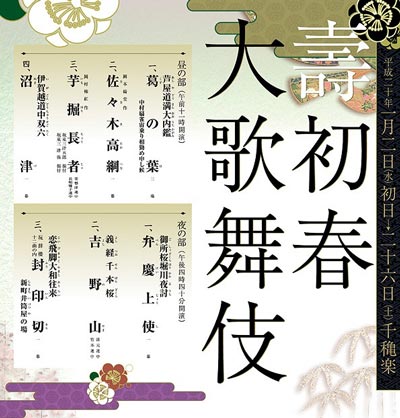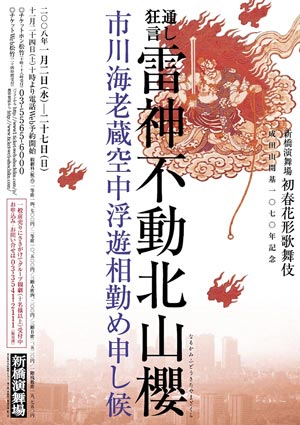| JANUARY 2008 |
|
6 shows in T˘ky˘ (Kabukiza, National Theatre, Asakusa K˘kaid˘, Shinbashi Enbuj˘), 2 in ďsaka (Sh˘chikuza) and 1 in Ky˘to (Minamiza)!
|
| Kabukiza (T˘ky˘) |  |
| Dates | 2 ~ 26 January 2008 (Kotobuki Hatsuharu ďkabuki) |
| MatinÚe |
Kiichi H˘gen Sanryaku no Maki Keisei Hama no Masago (Onna Goemon) |
| Evening | |
| Casting |
Ichikawa Danjűr˘, Nakamura Kichiemon, Nakamura Jakuemon, Matsumoto K˘shir˘, Nakamura Tomijűr˘, Nakamura Shikan, Nakamura Baigyoku, Ichikawa Danshir˘, Nakamura Kaishun, Kataoka Takatar˘, Nakamura Fukusuke, Ichikawa Sadanji, Nakamura T˘z˘, Nakamura Kinnosuke, Ichikawa Somegor˘, Nakamura Karoku, Nakamura Kash˘, Matsumoto Kingo, Ichikawa Komaz˘ |
| Comments |
2008 is an important year for the Kabukiza, which will celebrate its 120th anniversary. The year starts with an amazing program, which includes the revival of "Onna Goemon" and the staging of the great play "Sukeroku":
|
| Sh˘chikuza (ďsaka) |
| Dates | 2 ~ 26 January 2008 (Kotobuki Hatsuharu ďkabuki) |
| MatinÚe | |
| Evening |
Gosho Zakura Horikawa no Youchi (Benkei J˘shi) |
| Casting |
Sakata T˘jűr˘, Band˘ Mitsugor˘, Nakamura Hashinosuke, Kataoka Gat˘, Nakamura Kanjaku, Nakamura Senjaku, Kataoka Hidetar˘, Band˘ Yajűr˘, Kamimura Kichiya, Kataoka Shinnosuke |
| Comments |
|
 |
| National Theatre (T˘ky˘) |
| Dates | 3 ~ 27 January 2008 (Hatsuharu ďkabuki) |
| Program |
Komachi-mura Shibai no Sh˘gatsu |
| Casting |
Onoe Kikugor˘, Nakamura Tokiz˘, Sawamura Tanosuke, Band˘ Hikosabur˘, Onoe Kikunosuke, Onoe Sh˘roku |
| Comments |
Revival at the National Theatre of Sakurada Jisuke I's kaomise drama "Komachi-mura Shibai no Sh˘gatsu", which was staged for the first time in the 11th lunar month of 1789 at the Nakamuraza and was never revived before this 2008 production! In the Edo period, every November was the beginning of the theatrical year and all the Kabuki plays competed with gala plays to show off the new company for that season. This was the kaomise or "face showing" performance. Since these plays were usually more like spectacular events than fine dramas, most of those plays were never performed again, no matter how good. In January, the National Theatre is boldly reviving one of these plays for the first performance in 219 years. "Komachi-mura Shibai no Shogatsu" was first performed at the Nakamuraza in Edo as the kaomise in 1789 by master playwright Sakurada Jisuke I. It is a spectacular play on a grand scale, showing a struggle between two imperial princes for the imperial throne and the almost magical powers of the great poet Ono no Komachi, also considered one of the greatest beauties of her time. In ancient times, Komachi was such a famous figure that she became the subject of many N˘ plays, one in which her poetry called forth rain and another in which a jealous rival tried to defeat her by claiming that a poem she wrote was actually plagiarized from an old poetic anthology. She proved her innocence by washing the book of the anthology and showing that the fresh ink of the supposedly old poem easily washed away. For many years now, Living National Treasure Onoe Kikugor˘ has opened the year with adventurous new productions and January 2008 looks like it will be the most spectacular of them all. Also featuring Nakamura Tokiz˘, Onoe Sh˘roku and Onoe Kikunosuke. Source: Earphone Guide website |
 |
| Shinbashi Enbuj˘ (T˘ky˘) |
| Dates | 2 ~ 27 January 2008 (Hatsuharu Hanagata Kabuki) |
| Program | |
| Casting |
Ichikawa Ebiz˘, Nakamura Shibajaku, Ichikawa Monnosuke, Ichikawa Danjir˘, Ichikawa Emisabur˘, Ichikawa Shun'en, Ichikawa En'ya, Kataoka Ichiz˘, Ichikawa Unosuke, ďtani Tomoemon, Sawamura S˘nosuke |
| Comments |
T˘shi ky˘gen production of the spectacular drama "Narukami Fud˘ Kitayama Zakura", which includes "Kenuki", "Narukami" and "Fud˘" (which all belong to the Kabuki Jűhachiban). Ichikawa Ebiz˘ plays the roles of Kumedera Danj˘, the wicked priest Narukami, Prince Hayagumo, Abe Kiyoyuki and the Deity Fud˘ My˘˘. The role of Princess Taema is played by Nakamura Shibajaku. This program celebrates the 1070 anniversary of the Narita-san Temple, where the Deity Fud˘ My˘˘ is worshipped. |
 |
|
|||
| Dates | 2 ~ 27 January 2008 (Hatsuharu Hanagata Kabuki) | ||
| MatinÚe |
Keisei Hangonk˘ (Domo Mata) Benten Musume Meo no Shiranami
|
||
| Evening |
Gion Sairei Shink˘ki (Kinkakuji) Yowa Nasake Ukina no Yokogushi (Kirare Yosa)
|
||
| Casting |
Ichikawa Kamejir˘, Kataoka Ainosuke, Ichikawa Omez˘, Nakamura Shid˘, Nakamura Kantar˘, Nakamura Shichinosuke, Nakamura Kikaku |
||
| Comments |
The yearly show for young promising actors at the Asakusa K˘kaid˘ in the heart of Asakusa, a lively and colorful neighboorhood that keeps the scent of old Edo.
|
||
|
|||
| Dates | 3 ~ 22 January 2008 (Zenshinza K˘en) | ||
| Program | |||
| Casting | |||
| Comments |
(Three Thieves Named Kichisa) |
||
|
|
| Contact | Main | Top | Updates | Actors | Plays | Playwrights | Programs | Links | FAQ | Glossary | Chronology | Illustrations | Prints | Characters | Derivatives | Theaters | Coming soon | News |